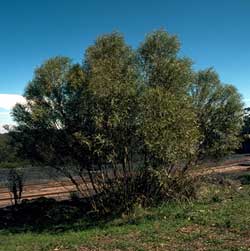Eucalyptus apiculata
 |
 |
Narrow leaved Mallee Ash
Eucalyptus apiculata R.T.Baker & H.G.Sm.
Eucalyptus apiculata or the Narrow-leaved Mallee Ash is a member of the family
Myrtaceae. E. apiculata is endemic to the Sydney and Blue Mountains area
of NSW and is designated as rare due to a limited distribution.
E. apiculata is a mallee, having multiple, slender stems emerging from a lignotuber at ground level. The tree grows from 3-6 m high and from 2-4 m wide. The stems are smooth-barked with white, cream, green and grey patches. Dead bark is shed in long thin strips.
The natural habitat of E. apiculata is on skeletal or podsolic soils on flat or undulating areas on the top of ridges or escarpments above gorges. The lignotuber is often visible due to the shallow depth of these soils.
The adult E. apiculata has alternate, narrow, glossy green leaves with a width of 0.3-0.7 cm and a length of 3.5-11 cm.
It flowers between December and January with white or cream flowers about 1.5 cm wide. These are borne on axillary, unbranched inflorescences of 7 buds. The fruit is 0.6-1 cm wide, and can be cup, urn or barrel shaped and persists on the branches.
E. apiculata is a small, hardy tree suitable for suburban gardens. It grows well around Sydney and has been grown successfully in Melbourne. The stems are manageable for pruning. The attractiveness of stems, bark and foliage and the interesting lignotuber lend it to an ornamental application. The natural habitat of E. apiculata provides some guidance to its horticultural limitations. It:
- requires a sunny position and well drained soil;
- is hardy to moderate frosts; and
- should not be planted closer than 5 m to buildings.
Propagation of E. apiculata is, as for most eucalypts, usually from seed. The bog method is recommended, where the tray or pot of growing media containing seed is placed in a shallow container of water. This allows the seeds to be kept moist by capillary movement of the water. Heat is not necessary although good ventilation is recommended. If seed is planted together in a tray then pricking out can occur after development of the first cotyledons with particular care to ensure the root is kept straight. Seedlings are tended for three to four months and then planted out in either spring or early autumn.
E. apiculata requires care during establishment including:
- watering if conditions are dry;
- the addition of a slow-release fertilizer suitable for natives; and
- monitoring for scale.
After establishment it generally requires little maintenance. Where it is planted in good conditions, or in shade, then it may not develop multiple stems. To stimulate mallee regrowth, cut back the stem to the base. Such pruning should not be done in extreme conditions such as drought or the middle of summer. Plants in poor to average conditions will usually develop the mallee form. This eucalypt with its mallee form and attractive bark makes an interesting feature for the larger native garden.
Text by Paul Cheeseman (2004 Student Botanical Intern)
Derivation of the name: Eucalyptus apiculataEucalyptus - Greek eu, well, kalyptos, covered; refers to the cap or lid which covers the flower bud. apiculata - Latin apiculatus, ending abruptly in a point; refers to the leaves. |
References
Association of Societies for Growing Australian Plants (2003) Available: http://farrer.riv.csu.edu.au/ASGAP/eucalypt.html 19/2/2004.
Australia’s Virtual Herbarium, Centre for Plant Biodiversity Research (2003) Available: http://www.cpbr.gov.au/avh/ Accessed: 19/2/2004.
Briggs, J.D. (1996) Rare or Threatened Australian Plants. CSIRO, Collingwood, Australia.
Brooker, M.I.H. (2000) A New Classification of the Genus Eucalyptus L’Hér. (Myrtaceae) in Australian Systematic Botany 13, pp. 79-148.
Brooker, M.I.H. & Kleinig, D.A. (1999) Field Guide to Eucalypts: Volume 1: South-eastern Australia Bloomings Books, Hawthorn, Victoria.
Brooker, M.I.H., Slee, A.V., Connors, J.R. & Duffy, S.M. (2002) EUCLID: Eucalypts of Southern Australia CSIRO Publishing, Collingwood, Australia.
Bureau of Mineral Resources, Geology and Geophysics (1976) SE Sheet - The Geological Map of Australia Scale 1:2,500,000 Bureau of Mineral Resources, Geology and Geophysics, Canberra, ACT.
Clarke, I. & Lee, H. (2003) Name that Flower: the identification of flowering plants Melbourne University Press, Carlton, Vic.
Elliott, W.R. and Jones, D.L. (1986) Encyclopedia of Australian Plants suitable for cultivation. Volume 4. Lothian Publishing, Port Melbourne.
Hall, N. & Brooker, I. (1973) Forest Tree Series No. 114: Narrow Leaved Mallee Ash, Australian Government Publishing Service, Canberra.
Kelly, S., Chippendale, G.M. & Johnston, R.D. (1978) Eucalypts Volume II, Thomas Nelson Australia, West Melbourne.
![An Australian Government Initiative [logo]](/images/austgovt_brown_90px.gif)

